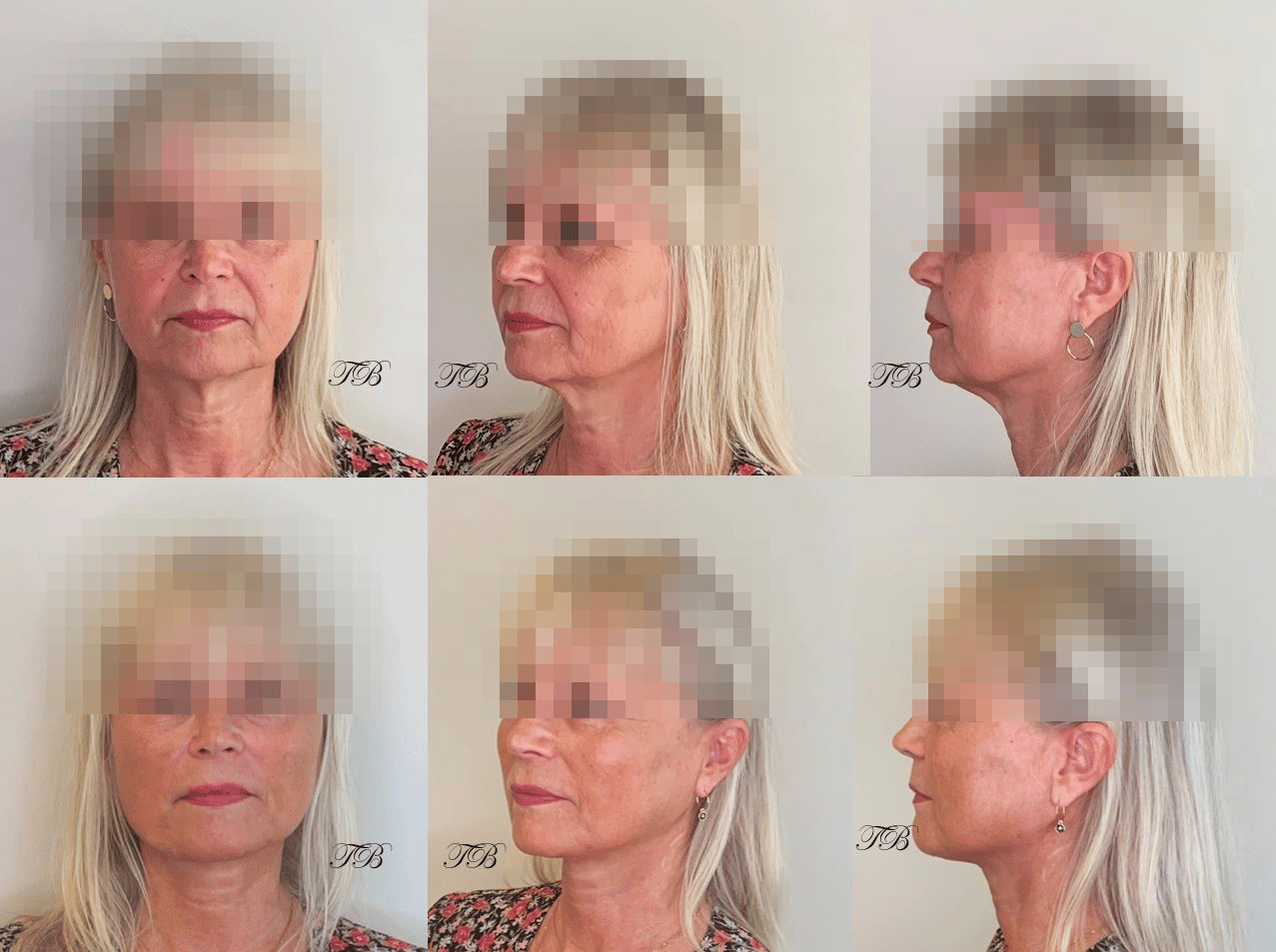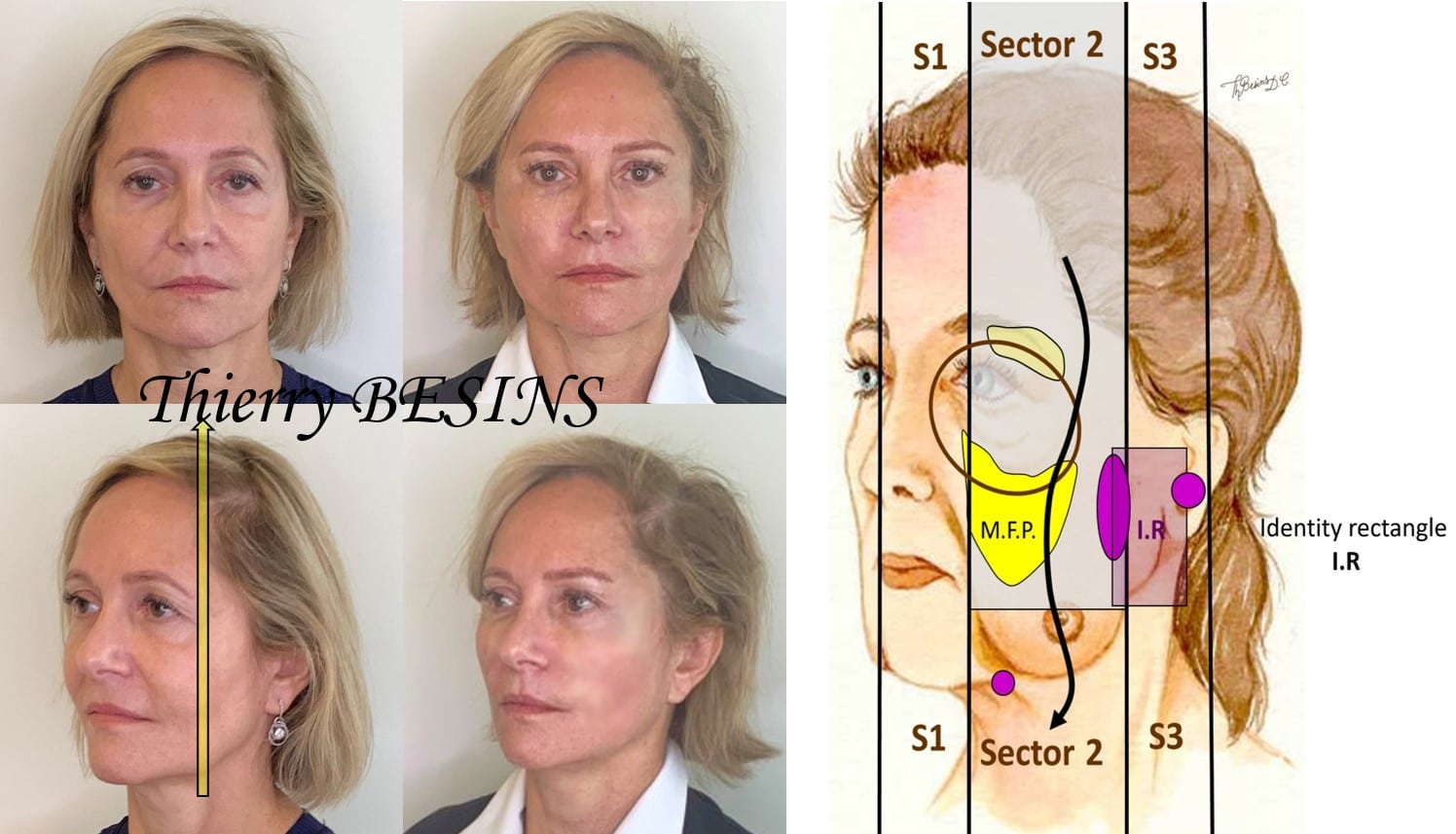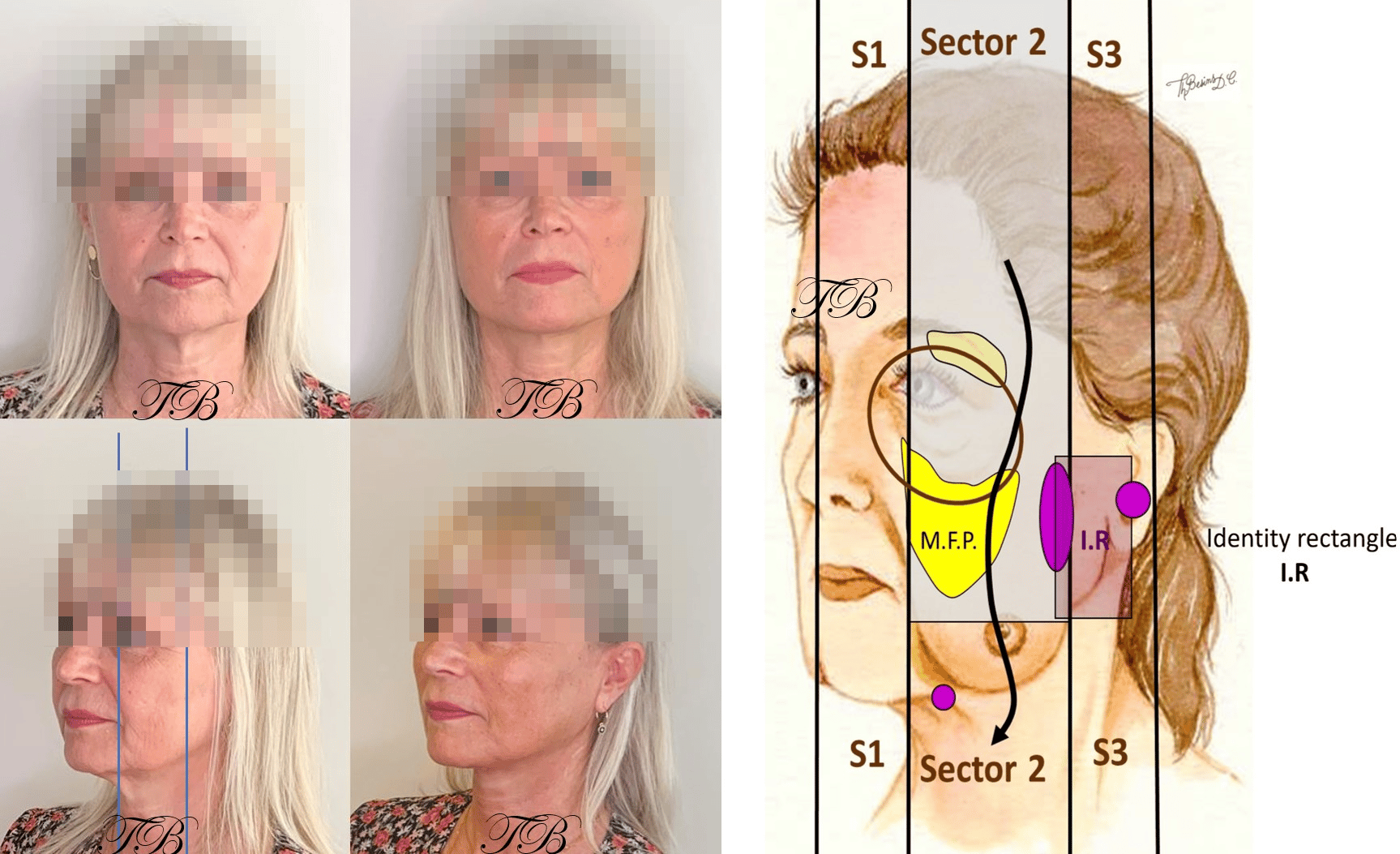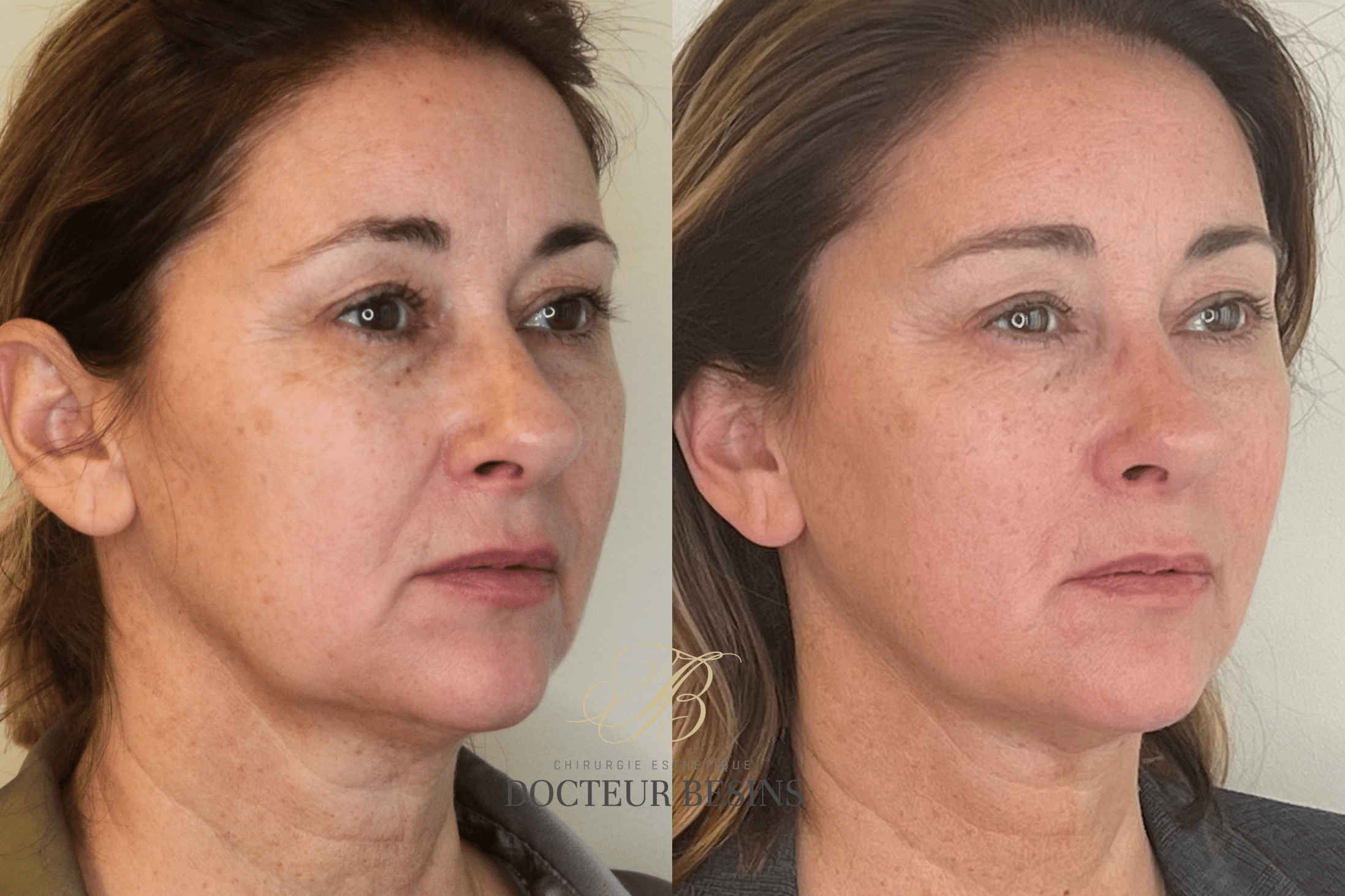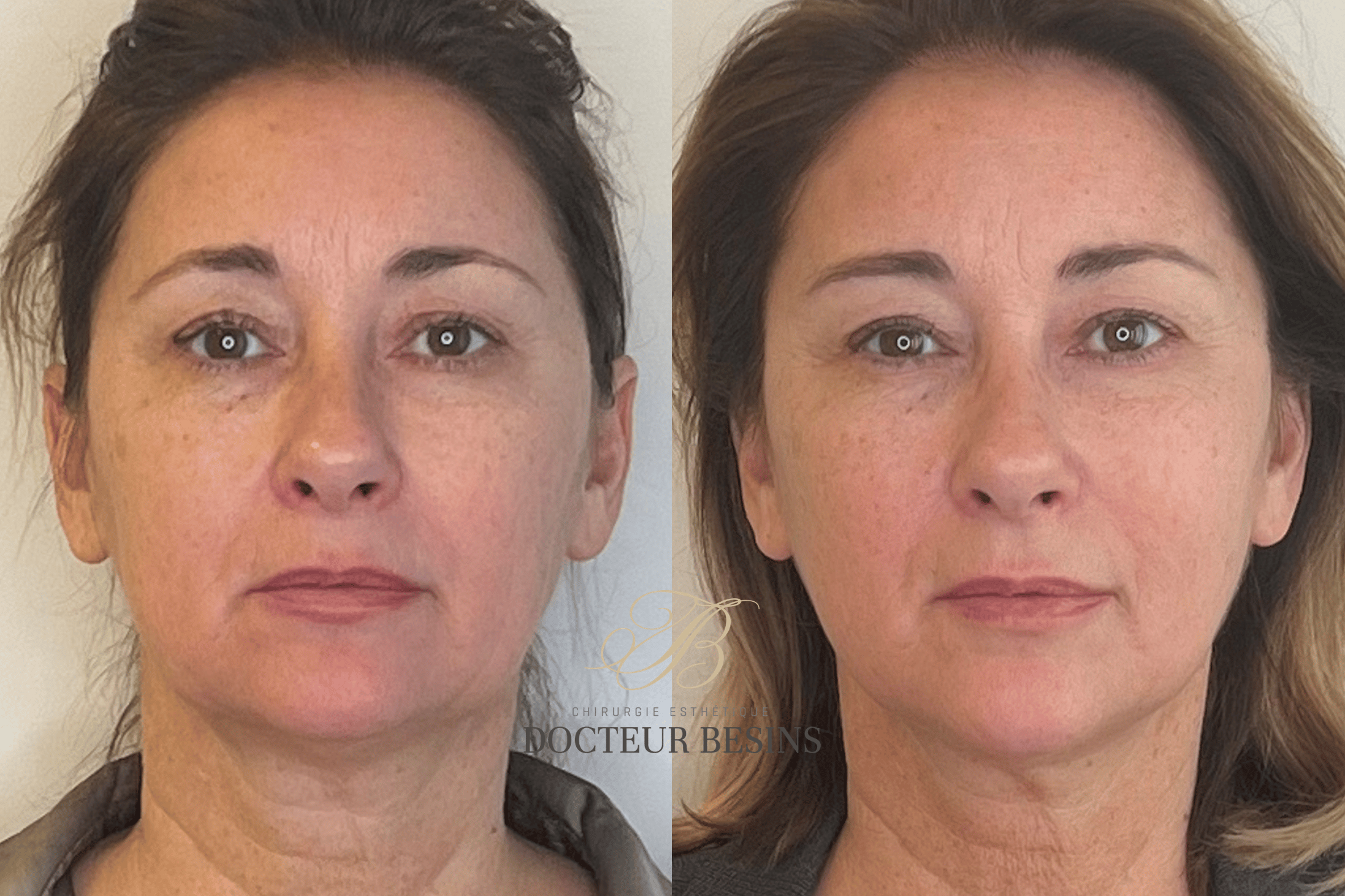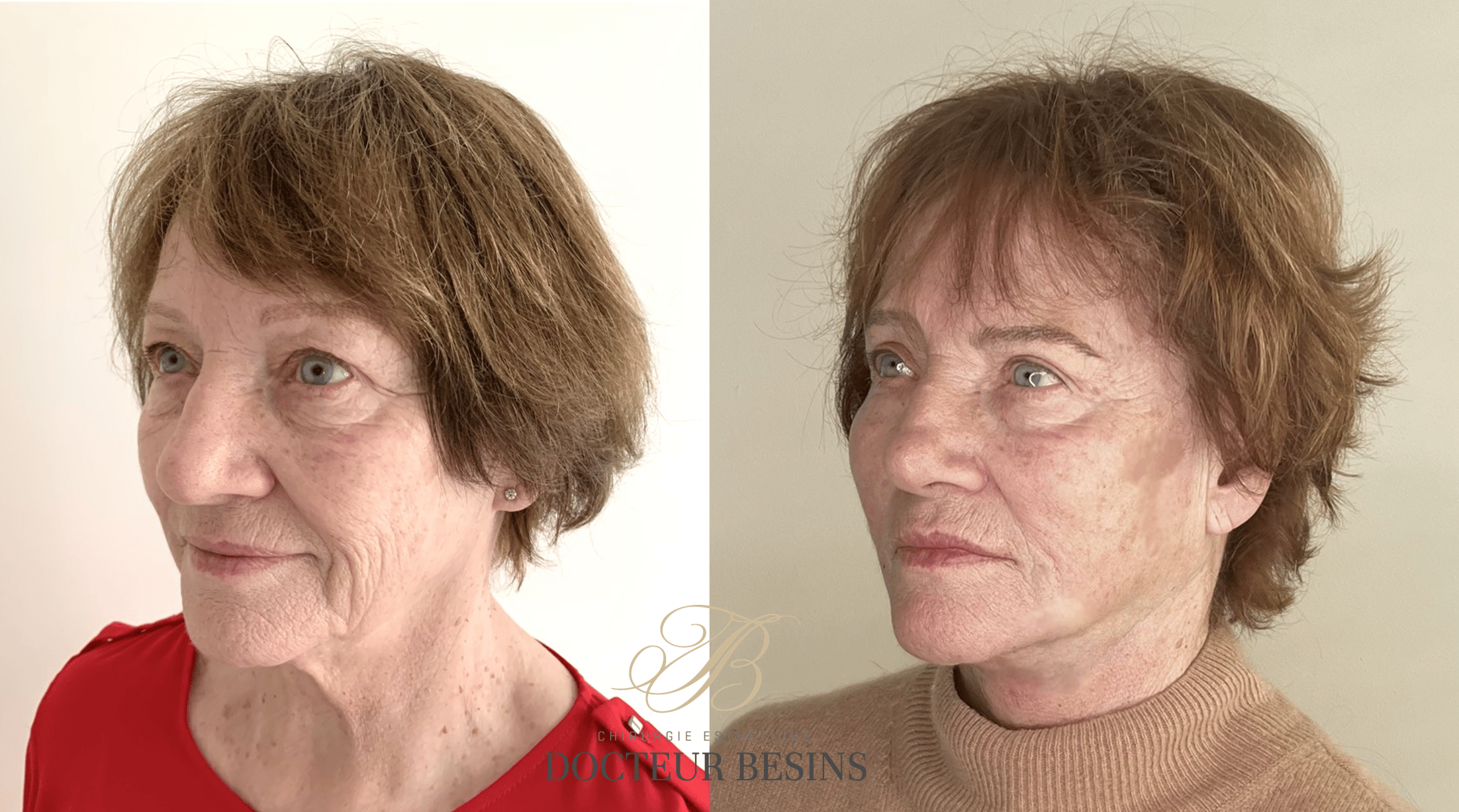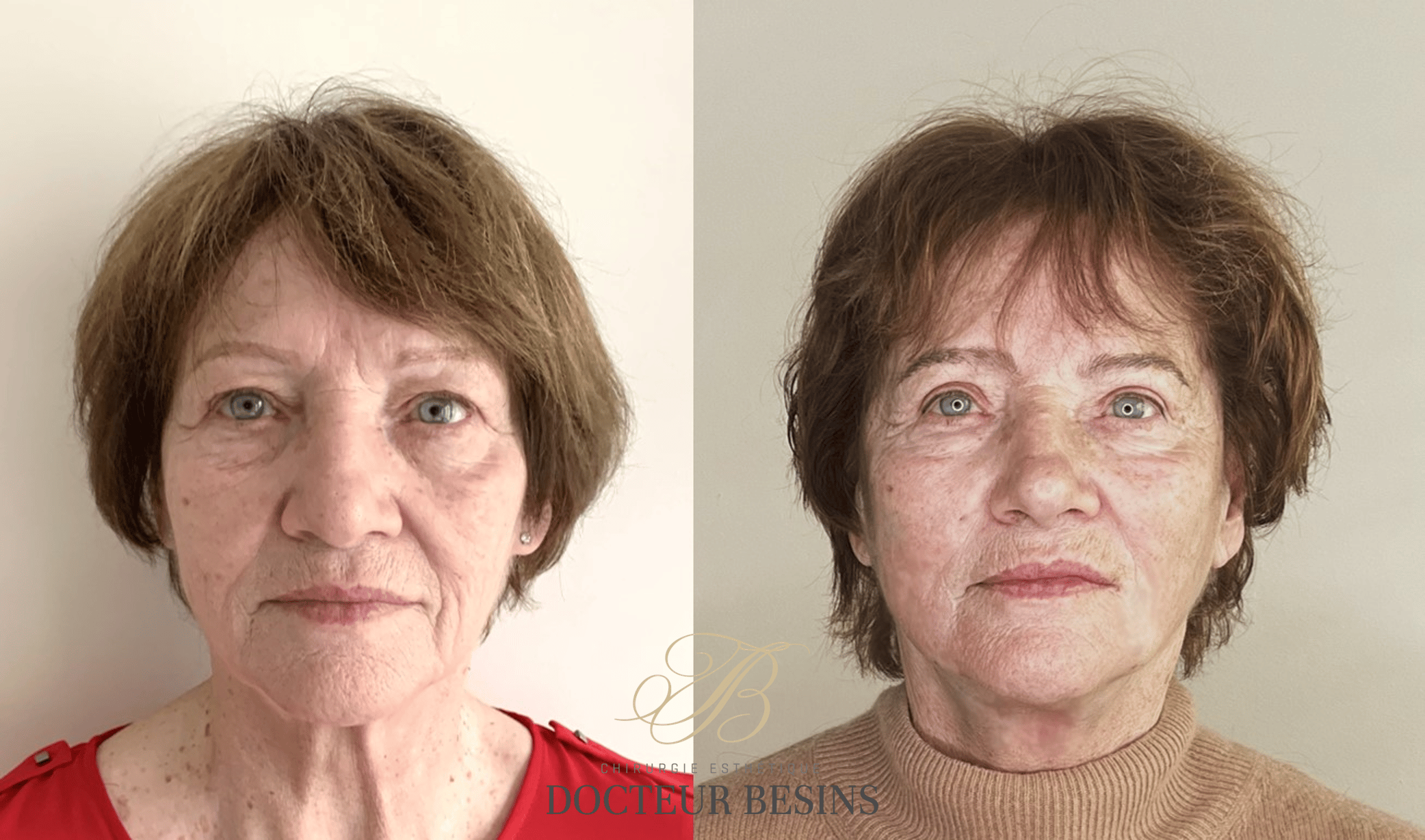Permanent suspension threads are the next decade’s facial rejuvenating revolution. We shall see why.
What is a suspension thread? Of course, it is a biocompatible thread, which means it may be “implanted” in the body; its structure and conception allow facial tissues to be replaced as they once were thanks to a system of cogs which catch the tissues and hold them in position once replaced.
Suspension threads have existed for many years but originally their use was confidential and suffered from scientific recognition, even though these barbed sutures were commonly used in other “non-surgical” interventions.
For further information on Infinite-Thread®, permanent suspension thread, consult the laboratory website on www.threadandlift.com
Understanding facial ageing and dispelling misconceptions :
One is continuously told that volume loss is the cause of ageing… therefore hyaluronic acid injections are all that are needed to avoid ageing and to “lift” the face!
That is totally untrue for several reasons:
Facial ageing is not caused by volume loss but by the fat pads sliding and spreading out… Such a movement alters the harmony of the contour lines, resulting in the emergence of shadows… Simply treating these shadows or hollows with fillers is illogical because their cause is not treated!
Take nasolabial folds for example. They are not formed by volume loss but by fatty cheek masses sliding downwards. Resetting of the cheek masses treats the nasolabial fold.
Sector theory helps understand the advantages of suspension threads in relation to the process of facial ageing.
Basically, a face may be divided into three areas to explain ageing.
In 2004 I developed this theory, which is now recognised, in a scientific paper “The RARE Technique” (Reverse And Repositioning Effect); it is the concept of a surgical technique which gives natural and long-lasting results whilst minimising surgical damage through sectorising the face.
1) Sector 1 or “Proface” is the centre of the face, which is relatively fix; it is the “red” sector where most of the facial expression muscles are to be found. The area ages little except for the upper lip which tends to stretch, as does the nose. (this is structural ageing due to modification in tissue levels).
2) Let us study sector 2 closely since it is practically totally made up of fat. This is the “Mesoface” or yellow sector. The sliding and spreading of this fat are the cause of visible ageing; eyebrow sagging, temporal area sliding, cheekbone sagging which causes nasolabial folds, hollowing of the tear troughs, heaviness of the jowls and slackening of the horizontal section of the neck…
We understand better why repositioning sector 2 is the key to rejuvenating the face. Use of suspension threads here proves both extremely successful and logical. By hooking and “lifting” they replace the fatty tissues to where they were “before” and the skin attached to them also falls back into place without any tugging.
3) Sector 3 or “Metaface”: this is the white area essentially made up of aponeuroses and fixed facial points (temporal, parotid, masseteric and muscular aponeurosis). This sector 3 is fixed and does not age. Facial expressions, thus one’s visual identity, centre around the sector. This sector and the identity giving fixed points are destroyed during a face lift.
We understand better why it proves so difficult to obtain natural looking results from a face lift. It is hard to retain one’s visual identity when all the identity giving fixed points have been destroyed.
The photo of this patient aged 54 illustrates the theory. Resetting sector 2 by means of threads gives a natural, harmonious youthfulness without surgery nor scaring.
The logic of using threads is now clear: “let’s be logical, put the trousers where they should be before doing the turn-ups” otherwise the face will swell and swell and end up looking nothing like it did before. It does not rejuvenate it just looks deformed, abnormal, monstrous!
In what way do permanent threads revolutionize facial rejuvenation?
- Because they give a real lift without surgery nor scaring
- Because there is very little vascular risk or risk to the nervous system.
- Because they do not require a general anaesthetic or hospitalisation.
- Because there is no surgical facelift-like damage (scars, undermining, facial modification, heavy postoperative treatment…)
- Because the results are always soft and natural looking. It is impossible to “alter” a face with threads as they respect the visual fixed identity points. It is easy to understand that any surgical undermining of tissues leads to a change in look, since moving and repositioning them to sites they never occupied leads to a certain distortion perceptible in many facelifts (facelift look effect).
- Because post-operative care is easy: some patients may eat at a restaurant the same evening and resume their activities just days after the intervention.
- Because they have a preventive and therapeutic effect. They are permanent threads which are efficient and long lasting due to their hooking ability.
- Because they may be used for people of any age, because there are no negative consequences in the short, medium or long term… We can offer suspension threads to the very young without any sense of guilt because they are inoffensive and reversible (they may be removed at any time). Elderly or fragile people with comorbidities forbidding surgery may benefit too.
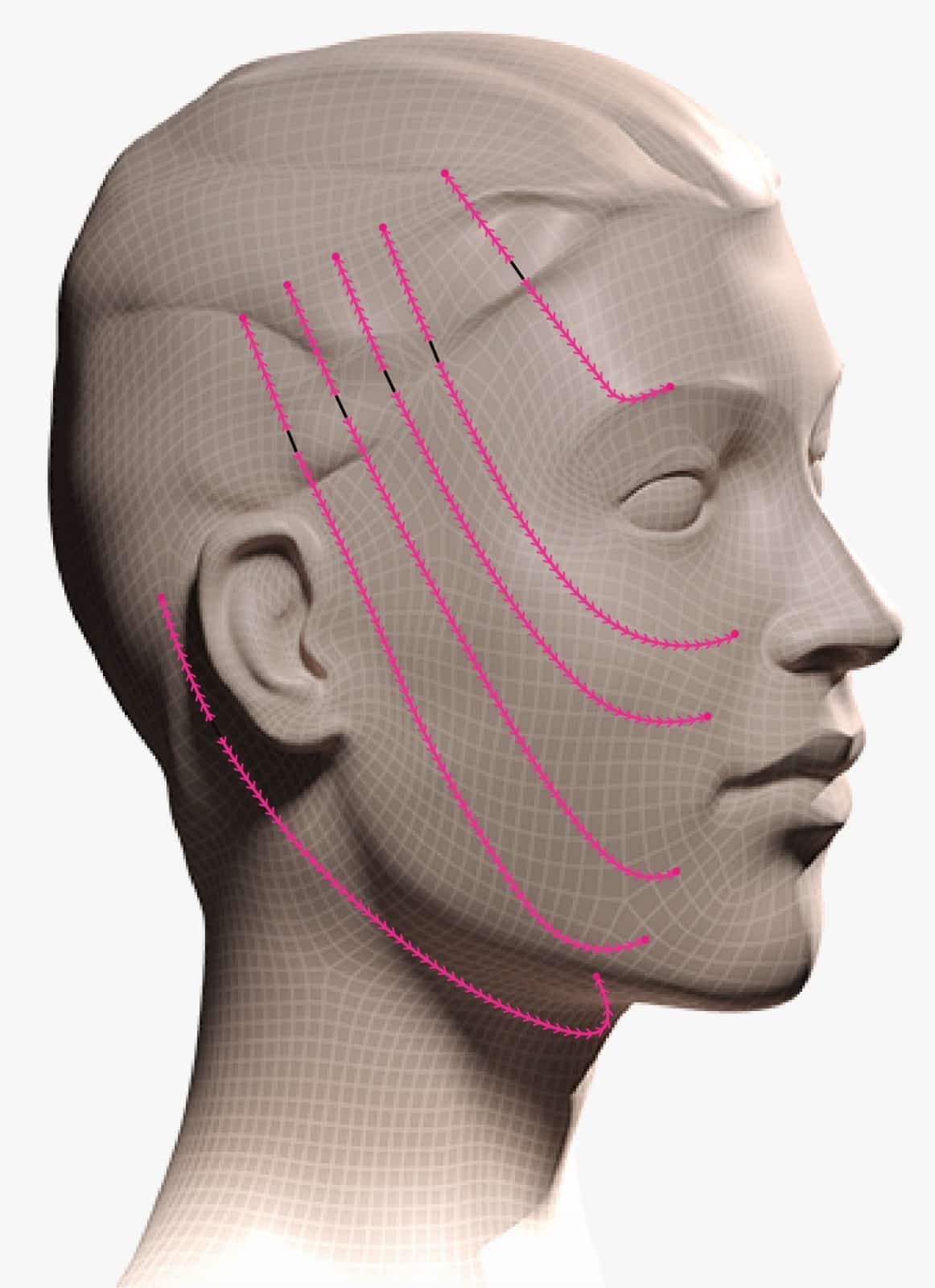
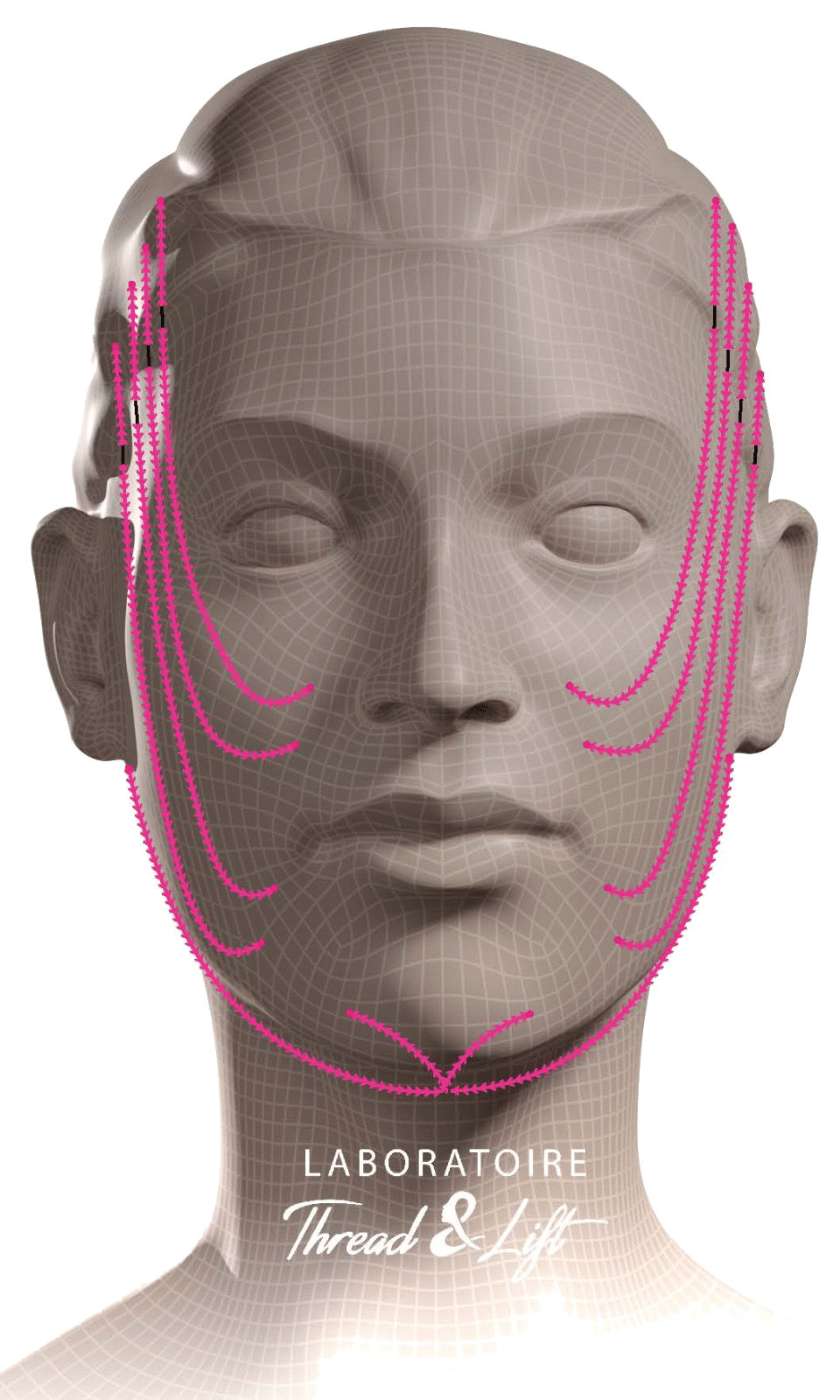
Questions often raised concerning suspension threads:
1. What is the difference between resorbable and permanent threads?
Resorbable threads resorb slowly losing efficiency over time (in just a few months). Permanent threads stay where there were inserted for ever and are therefore efficient over a long period of time (providing the tissues surrounding them on to which they are hooked maintain good density and good hooking quality like any operation concerning repositioning like face and breast liftings).
2. Can they be removed?
Yes, they can be removed any time if needs be or if the patient requests it. But this is rarely done.
3. Are they visible? Are they uncomfortable?
No! They are not uncomfortable nor are they visible, regardless of facial expressions. However, they may be slightly visible if the thread has been inserted too superficially (it would amount to a technical error or an error of decision for “gaunt” or very thin faces with little volume).
4. How long do they last?
They last forever and remain efficient so long as there is volume, and the connective tissue maintains its density. The durability of the results is similar to that of a face lift in that it depends on genetics, tissue quality of the skin in particular and thus of a healthy or unhealthy lifestyle.
5. Would they cause a problem for later facial interventions?
Absolutely not… They are very fine threads, similar to those used in face lifts….in no way are they an obstruction for surgical interventions; they may be cut and removed at any time, without problem, if necessary and with no particular aesthetic consequences.
6. Are there any risks of complications?
No technique is without risk. But complications using threads are rare since any surgical complications are in theory non-existent. Possible complications are not serious but may be uncomfortable (or annoying):
- A little pain round the temporal hooking area for a few days.
- An infection is always a possibility but very rare. It requires the removal of the thread. Healing is prompt and a new thread may be inserted two months later; curiously, this does not affect the visible result as the presence of other threads maintains it.
- The main complication, if complication it is, is a slight defect: it may be possible to guess the position of the thread in certain lighting or angles, but this is due to incorrect insertion (too superficial) or to an error of judgement (tissue not dense enough and poor-quality connective tissue).
7. At what age can one have a thread lift?
There is no age limit – an extraordinary advantage of permanent threads.
Why? Because thread insertion is harmless, non-surgical, reversible, scarless, with no undermining and is performed under local anaesthesia. Tissue remains intact. Blood vessels and nerves are untouched. Moreover, we can confirm that threads do not alter visible identity since they reset tissues in their original location. It is therefore impossible to alter the visible identity of a person.
Anyone between the ages of 20 and 90 may undergo a thread lift as there is no risk involved! There result will always be a positive; the extent of which will have to be determined with the patient to avoid any disappointment.
Finally, threads open new possibilities for patients between the ages of 40 and 60 who are still magnificent despite some minor shortcomings. A face lift can wait, and the threads will allow to correct the first signs of ageing (nasolabial fold, slackening of the jowl or neck) non-invasively, without surgery. Also, threads prevent ageing since they maintain tissue in the correct place for many years.
8. In what cases are threads suggested?
Whenever you do not want to undergo surgery or have scars.
When slacking begins and you are worried about your appearance or that you wish to remain youthful.
When you wish to open up your eyes, correct your tear troughs, nasolabial folds, oval , jowls and/or neck.
When you have already had one face lift and do not want another.
When you become disappointed with injections which swell the face but do not “lift” it. When you have understood that it is indeed logical to reset tissue in its original position rather than filling it in a bad position!
When you are afraid of looking like an over-filled caricature (lips, cheekbones, heavy unnatural-looking cheeks).
At any age to regain a youthful but natural look
And finally, threads may also be combined with surgical procedures to minimise surgery, optimise results and reduce post-operative care.
9. Any Contra indications?
As with all techniques there are contra indications to avoid a mediocre or inadequate result:
1) Too much skin sagging which would require an excision; for this reason, it is better to undergo a thread lift sooner rather than later to avoid a surgical lift.
2) Tissue which is too thin with ill-defined fatty compartments means that threads do not hook well and may result in the thread being “visible”.
3) Patients demanding the impossible or who have not fully comprehended the technique and its limits, and who would be disappointed.
10. How does the intervention unfold?
The procedure lasts between one and a half and two and a half hours according to the number of threads to be inserted. The procedure is performed under local anaesthesia either in the practice or at a clinic, where strict asepsis rules are in place.
How does it unfold?
On arrival I will personally meet you to answer any last-minute questions you may have. Then my fully qualified nursing assistant will help you into your gown and ascertain you have correctly followed the pre-operative instructions sent to you days or weeks before the intervention.
My assistant will once more clean your face and hair and advise you on care over the next few days.
Then, once seated, with a mirror, we decide and draw the thread lines required to give you the result you wish for. You may alter or modify the effect of each thread (e.g. the tail of the eyebrow or the cheekbone). This takes time but is totally necessary for a good result.
Then you lie down. Small hair partings are made on the scalp following the route the threads will take towards the upper part of the face. These specific routes are essential to ensure the lifting and hooking of the facial tissue.
The local anaesthesia comes next, very precise, all along the thread routes. The face does not swell. Like at the dentist’s the injection of anaesthetic may hurt just a little. It is done using small flexible blunt cannula that are slid along the route.
Now comes the thread insertion. This does not hurt. You are conscious of my movements, but it does not hurt. From time to time you will feel the tissues being lifted painlessly; this is what you desired.
Once the threads have been inserted, generally speaking, there is no bruising or important oedema to speak of. I shall ask you to sit up so we may decide together on the final result.
Mirror in hand, we decide together on “a little more” or “a little less” at such and such a spot….The final result is immediately visible. We can increase or release the tension of the threads as you wish. Two areas may surprise you: a cheekbone that may appear “a little too much” is just a passing impression as is a lowered, immobile eyebrow (this impression on the eyebrow that will disappear when the anaesthetic wears off just like at the dentist’s).
When we are happy with the final result, I cut the threads at their exit point. You may then comb your hair, rest a while if you wish to and return home.
11. What happens over the next few days?
Everything is fine since you should be very pleasantly surprised by the result. Your face is a little numb still. There is no pain except perhaps at temple level where the skin feels stretched and might cause an uncomfortable first night’s sleep.
You will have received a very detailed medical prescription to tide you over the first few days if needed. The majority of our patients take no drugs at all!
Very rarely, there could be a minimal amount of swelling or a bruise around an exit point.
Your social life is not affected. Your acquaintances will find you beautiful, totally astonished even at how natural looking the result is….The actual procedure will be forgotten within a few weeks, but your social life will not be hampered during this time.
No vigorous shampooing or blow-dries for 2 weeks and no facial massage since massaging could bring about inflammatory reactions that may cause oedema just through irritation.
You may lead a normal life but avoid intensive sport and saunas.
When possible, we meet one or two weeks later to confirm that healing is going well and to answer any remaining questions or worries.
As you see, this is a simple procedure with rapid results, with practically no effect on your social life on condition that the procedure has been fully understood and my advice followed.
Why are threads considered a huge breakthrough in the field of plastic surgery?
– Because they avoid surgical lifts.
– Because they are not dangerous and may be inserted at any age.
– Because they play a role in preventing aging.
– Because they may be used in conjunction with surgical lifts to optimise results and/or to decrease the weight of the surgical intervention.
– Because they allow surgical lifts to be touched-up or optimised without the need for any further surgery; a small jowl, a nasolabial fold not quite rectified, a cheekbone not lifted enough, etc.
– Because they will allow to diminish the current popular over-usage of injections in the face, which do not treat the causes and simply remedy an error by another error: a swelling and abnormal, even monstrous, look. An injection fills the space but does not return tissues to their original position.
For further information on” Infinite-Thread®” which I use, visit the laboratory’s website www.threadandlift.com

